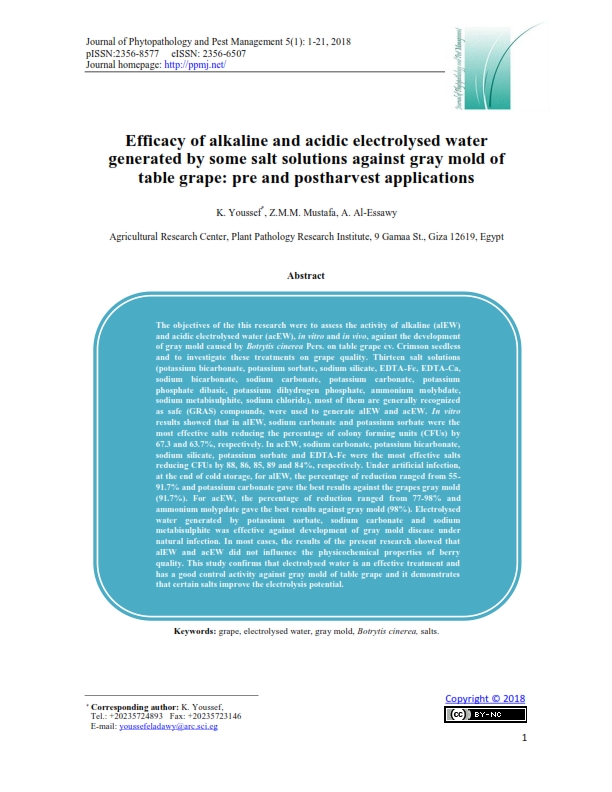Efficacy of alkaline and acidic electrolysed water generated by some salt solutions against gray mold of table grape: pre and postharvest applications
Keywords:
grape, electrolysed water, gray mold, Botrytis cinerea, salts.Abstract
The objectives of the this research were to assess the activity of alkaline (alEW) and acidic electrolysed water (acEW), in vitro and in vivo, against the development of gray mold caused by Botrytis cinerea Pers. on table grape cv. Crimson seedless and to investigate these treatments on grape quality. Thirteen salt solutions (potassium bicarbonate, potassium sorbate, sodium silicate, EDTA-Fe, EDTA-Ca, sodium bicarbonate, sodium carbonate, potassium carbonate, potassium phosphate dibasic, potassium dihydrogen phosphate, ammonium molybdate, sodium metabisulphite, sodium chloride), most of them are generally recognized as safe (GRAS) compounds, were used to generate alEW and acEW. In vitro results showed that in alEW, sodium carbonate and potassium sorbate were the most effective salts reducing the percentage of colony forming units (CFUs) by 67.3 and 63.7%, respectively. In acEW, sodium carbonate, potassium bicarbonate, sodium silicate, potassium sorbate and EDTA-Fe were the most effective salts reducing CFUs by 88, 86, 85, 89 and 84%, respectively. Under artificial infection, at the end of cold storage, for alEW, the percentage of reduction ranged from 55-91.7% and potassium carbonate gave the best results against the grapes gray mold (91.7%). For acEW, the percentage of reduction ranged from 77-98% and ammonium molypdate gave the best results against gray mold (98%). Electrolysed water generated by potassium sorbate, sodium carbonate and sodium metabisulphite was effective against development of gray mold disease under natural infection. In most cases, the results of the present research showed that alEW and acEW did not influence the physicochemical properties of berry quality. This study confirms that electrolysed water is an effective treatment and has a good control activity against gray mold of table grape and it demonstrates that certain salts improve the electrolysis potential.Â
Metrics

Published
How to Cite
Issue
Section
License
Authors who publish with Journal of Phytopathology and Disease Management agree to the following terms:
- Authors retain copyright and grant the journal right of first publication with the work simultaneously licensed under a Creative Commons Attribution License that allows others to share the work with an acknowledgement of the work's authorship and initial publication in this journal.
- Authors retain copyright and grant the journal right of first publication with the work simultaneously licensed under the Creative Commons Attribution-Non Commercial License (CC BY-NC). This allows others to share the work with an acknowledgement of the work's authorship and initial publication in this journal.
- Archives of Agricultural Sciences Journal is an Open Access Journal, and articles published are distributed under the terms of the Creative Commons Attribution-Non Commercial License (CC BY-NC). Readers may copy, distribute, and display the work for non commercial purposes with the proper citation of the original work. However, the journal retains the right to exploit subsidiary rights on behalf of the authors.
- Authors are able to enter into separate, additional contractural arrangements for the non-exclusive distribution of the journal's published version of the work (e.g. post it to an institutional repository or publish it in a book), with an acknowledgement of its initial publication in this journal.
- Authors are permitted and encouraged to post their work online (e.g., in institutional repositories or on their website) prior to and during the submission process with full disclosure to the journal, as it can lead to productive exchanges, as well as earlier and greater citation of published work. Following publication in Archives of Agricultural Sciences Journal, the author should update the repository, and include a citation and link to the published work.
Click here for more information on Licensing policy
.png)




